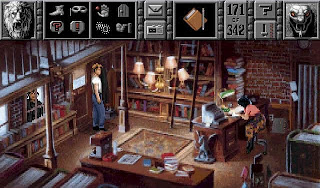| Riven is considered a good game with some very hard puzzles that contain both good and bad elements. |
Some puzzles just do not make any logical sense; Others lack any type of understandable clues to give the player a chance of understanding what he is suppose to do; And even when the player understands the puzzle and the solution is logical it does not mean the puzzle is fair, many puzzles require the user to follow a strict path with only one possible correct solution even while they are many other perfectly logical but incorrect solutions.
Additionally, some puzzles are can be extra challenging for certain people. As both somewhat tone deaf and colour blind, I have trouble with many adventure puzzles. I do not think I have encountered a compare sounds or colours puzzle without resorting to a walkthough or randomly trying answers.
All of these "unfair" puzzles can cause player frustration and kill any fun the game might of given without these obstacles. But not everyone is against these masochistic puzzles. Some people like the challenges given by these puzzles, and deservedly derive much satisfaction from finally beating a brutally challenging game. And they do add a sort of realism; As in real life not all goals have obvious paths leading to them; People are not guarantied to be warned of impending death; And it is not always obvious what tasks are completable and which are not before setting out to accomplish them.
 |
| Zork I made unwinnable in 6 turns. The garlic is needed to complete the game. |
One of the worst in my opinion is unwinnable situations, making it impossible for the player to complete the game; This situation is also called zombie, dead end, and walking dead. In most situations this comes about by the player not having access to an item needed in a puzzle. The most annoying part of this situation is that often the player has no idea this has occurred and will continue to play the game and then to bash their unknowing heads again the unwinnable puzzle. In addition, some games even become unwinnable very early in the game, without warning and with the impassable puzzle far at the end of the game.
One good example of unwinnable situations in gaming is the infamous The Hitchhiker's Guide to the Galaxy, first released in 1984 by Infocom as a text based adventure. It contains many unwinnable situations, where the player has no idea he will not be able to complete the game until much time has passed. For example, the very first scene contains two objects (the screwdriver and toothbrush) that need to be taken before the world is destroyed, as they are necessary to finish the final puzzle at the end of the game. Additionally, to avoid an unwinnable situation, a pile of junk mail must be taken from the protagonists house as it is needed off world (who would of thought).
Another classic adventure puzzle frustration is pixel hunting; Pixel hunting is an exclusive of graphical adventure games and occurs whenever a necessary item is hard to see. In many cased these objects are quite small containing very few pixels. I know of situations where a needed object is as small as 2x2 pixels. This can cause gamers to just weave their cursor back and forth across the screen in searching patterns looking for intractable areas, or to just try clicking everything that looks like a separate object if the game does not inform players of intractable areas. With resolution now many times what it used to be, pixel hunting is has greatly decreased in games.
The third and final specific frustration I am going to talk about is guess the verb/noun. This for the most part only occurs in text adventures and is the text adventure equivalent of pixel hunting. It occurs when the player knows the solution to a puzzle, but cannot express the solution in words that the game can understand. This can even be caused by using syntax that the game simply does not understand.
But in the end while I find all of these issues extremely frustrating, others can still enjoy them. But personally I have enjoyed moderately easy adventure games more then the extremely challenging ones.


.png)













